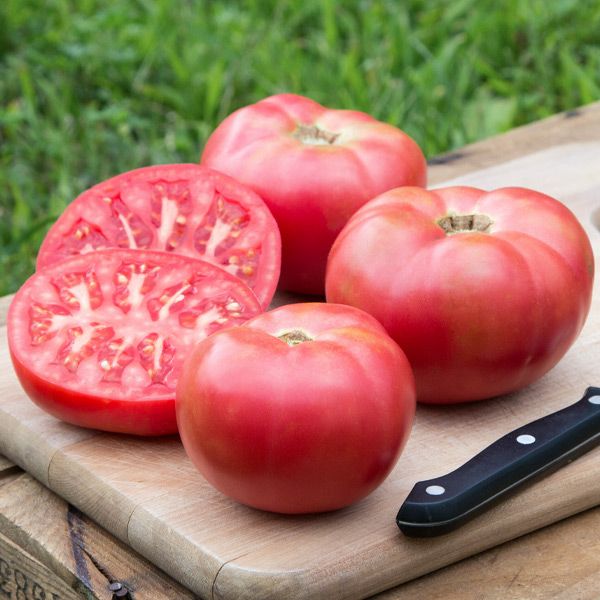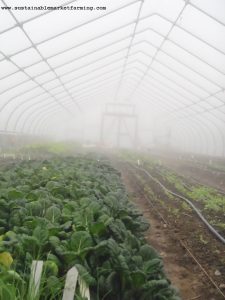
Photo Pam Dawling
Vegetable Seed Varieties for 2024
Have you ordered your seeds for next year yet? The earlier you order, the best chance you have of getting the varieties you want. Later, some will sell out. It’s true that when you order very early, some seeds won’t be available yet. The seed growers are still drying and cleaning them, weighing them and running them through germination testing. Your patience will be rewarded with high quality seeds.
I love looking through catalogs to find new exciting-sounding varieties! After so many years of gardening, I’ve tried lots of different kinds, and have definitely grown attached to some reliable favorites. I recommend planting a small amount of a variety new to you that sounds good, alongside your usual well-loved variety. And what do I mean by “sounds good”?
In 2014 I wrote Reading Between the Lines in the Seed Catalogs to share what I’d learned about decoding catalog-speak, and not getting distracted by wondrous claims, failing to notice the catalog never even claimed it had good flavor. Or high yields. Or good disease-resistance. That post lists 15 features to look for.
We look for flavor, productivity, disease-resistance, an appropriate fit with our climate or latitude, general adaptability, varieties that don’t require erecting elaborate trellises, ones that don’t sprawl too widely, ones that don’t take a really long time to reach maturity.
If we’ve had a few years of poor performance from a crop, we’ll try several new varieties. We have done trials of heat-tolerant eggplants, winter spinach for the hoophouse and outdoors, storage cabbage, and now we need to start over with broccoli.

For many years we grew three varieties of hybrid broccoli with different number of days to maturity. That enabled us to sow them all on the same day, transplant them all on the same day (or in the same week), and get an extended harvest period. Some of our favorites dropped out of the market, we floundered with various kinds, including some Open Pollinated varieties that sounded good. This year I am advocating for Green Magic (57d F1, 6-8″ main head and sideshoots too); Belstar (65d F1, also 6-8″ main head, plus sideshoots); and Marathon (68d F1) or Fiesta (70d F1, 6-7″ head, few sideshoots, short harvest window). Marathon has done well for us in the past. In my experience, broccoli is a crop where hybrids are much more productive than OP types.

Our much-loved Tendergrey zucchini, one of the flecked pale green types, isn’t easily available this year. But Green Machine (45d F1) sounds very good! Open plant habit is a phrase I like. Moderate spines is one I don’t like, but we have some pull-on plastic sleeves to deal with irritating plants. Widely adapted, excellent disease package, and high yields all appeal to me.
We rely on Provider (50d OP) and Bush Blue Lake snap beans every year, with a short row of Strike in the hoophouse a month earlier than outdoors. We found we need an upright variety to get nice beans undercover, as the bean plants grow sprawlier than they do outside, and we don’t want to be treading on them.

Photo Wren Vile
We rely on Cylindra or Formanova (54d OP) beets, long-shaped tender ones that grow up out of the ground, are tender and easy to peel after cooking. Seems like the yield must be high when half the root is above ground, and half below!
Premium Late Dutch cabbage (100d OP) has done well for us. Johnny’s has a lovely-sounding storage cabbage, Promise (96d F1). 6 ½ lbs at 18″ spacing, 9-10 lbs at 24″ spacing. And two attractive purplish Chinese cabbages Red Trumpet (60d F1), a tall Michihili type, and Merlot (60d F1), said to be an improved Red Dragon Napa type. I hadn’t got round to trying Red Dragon yet, so I can’t speak to its shortcomings. Merlot admits to being more prone to tipburn than green varieties and to be somewhat susceptible to bolting. Some trials on a small-scale are called for!

Photo Johnny’s Selected Seeds
Carrots – oh why so many yellow, purple, red and black ones? None in my experience match the succulence and growth rate of orange Danvers 126.
Collards – for years I have loved Morris Heading, but the recent explosion of options brought us by the Heirloom Collard Project is leading us to try others. Some have remarkable colors, combined with high yields.
The delicious early Bodacious sweet corn is harder to find. Thanks Southern Exposure for carrying it. Our reliable favorite Kandy Korn has become hard to find.
Our favorite slicing cucumber has been renamed by Fedco as Generally, a name we’ve been using for years. This year we also tried South Wind from Common Wealth Seed Growers and were quite taken with its sweetness.

Photo Common Wealth Seed Growers
As always, there are new frilly mustards for baby greens and salad mixes. We like Mizuna, Golden Frills, Scarlet Frills and especially Ruby Streaks. I feel drawn towards purple stemmed Ember and dark red Miz America.
For leeks, we grow King Richard and Lincoln for fall and Tadorna for overwintering in our Zone 7a climate. No complaints there. all are very good for their purpose.
I’m always on the lookout for new lettuces. This summer we tried Albachiara from High Mowing, and it did very well. We’ll get more for this coming year. It’s a Batavian heat-tolerant type. Now our climate is changing, we need to grow Batavians for more weeks of heat. Finding a new one is great! Dark red Cherokee has been my favorite.
I shouldn’t even look at the spring lettuce selection, or I’ll order more than we can use in the short spring season we have. Most spring varieties can be grown in the fall here too, but we like to switch to cold-tolerant ones.

Photo Wren Vile
This winter we are growing the beautiful Rhone in our hoophouse bed of cut-and-come again leaf varieties, along with Ezrilla, Hampton, Brentwood, Tango, Revolution, Oscarde and Panisse.
For scallions we like Evergreen Hardy White (65d OP) every time, and feel no need to try another.
We have been growing Sugar Ann early dwarf snap peas in our hoophouse (sown Feb 1), but next year we are trying Oregon Giant snow peas instead. We think snap peas are best raw, and used to cut them into our salad mixes. But over the past few years, by the time the snap peas are ready to harvest, our winter salad mix days are coming to a close, and our outdoor lettuce head harvest is starting. We don’t grow enough snap peas to serve them on their own in big bowlfuls. We think we’ll be able to pick enough snow peas for stirfry mixes instead! In March we sow Sugar Ann outdoors and get plenty.
For sweet peppers our keywords are prolific, thick-walled, tasty, and 90 days or less from transplant to ripe harvest (76d to green). We like fairly large peppers too, and avoid small pointy ones that could get confused with hot peppers in the fridge.
Tomatoes are a whole topic on their own. We love Sun Gold and Black Cherry, Mountain Magic and Garden Peach. Others come and go. Next year we are trying Damsel (73d F1). Damsel is in the new tomato category called “Hylooms” – hybrids resembling heirlooms in color and flavor, with added disease resistance.

Photo High Mowing Seeds


